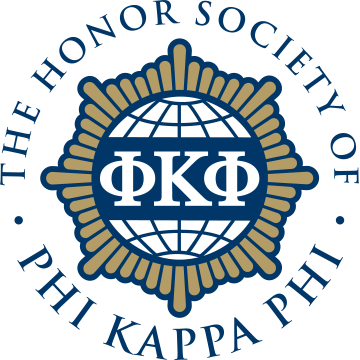History of Phi Kappa Phi
In 1897, Marcus L. Urann, a student at Maine State College (now the University of Maine) proposed to his professors an honor society built upon a broader base and with wider purpose than any in existence at the time. At the request of college president Abram Harris, Urann drafted a constitution and set of bylaws for such an organization. Urann and Harris, assisted by interested professors, succeeded in organizing the Lambda Sigma Eta Society, an academic honor society open to superior students regardless of academic discipline. Ten students were elected to membership that first year. After Urann’s graduation, President Harris assumed the responsibility for promoting the society.
In 1900, with strong support from the presidents of the University of Maine, Pennsylvania State College (now Pennsylvania State University), and the University of Tennessee, the society became a national organization. In the same year, the society was renamed Phi Kappa Phi from the initials of three Greek words of its adopted motto. Today, there are more than 300 chapters of Phi Kappa Phi, ranging from Maine to the Philippines and from Alaska to Puerto Rico.
The badge of the society is a globe against the background of the sun, whose rays form an expansive corona and radiate in a number of symmetrical and equal concentrations from behind the globe. These signify equivalence among the various branches of learning and represent dissemination of truth as light. Encircling the globe is a band containing the Greek letters FKF (Phi Kappa Phi). It symbolizes a fraternal bond which girds the earth and binds the lovers of wisdom in a common purpose.
The seal of the society features the badge at its center. The badge is surrounded by a crenellated line that represents the battlements and walls of Troy. In the space between this line and the periphery of the seal appear three stars just above the badge, one for each of the three original chapters. Below the badge is the phrase “Founded 1897.”
The ribbon of the society is a meander pattern that is common in ancient Greek art and symbolizes the classical features of the society.
The first word of the Phi Kappa Phi motto is Philosophía (fe-loh-so-FI-uh, with “FI” as in “fee” not “file”). For historical reasons, the society translates this Greek word as “the love of learning.”
The second word of the motto is Krateítō (Krah-TAY-toe), a verb meaning “to rule.” In our motto, the word has the form of a strong exhortation that calls on us to “let the love of learning rule.”
The last word of the motto is Phōtôn (Foe-TONE). This word occurs in ancient Greek poetry and drama with reference to mortals in contrast to immortal gods. In our motto, it refers to all humans—women and men—so we translate it as the word “humanity.”
Thus, in saying the Phi Kappa Phi motto, Philosophía KrateítōPhōtôn, you are calling on yourself and others to have your lives ruled by the love of learning.

